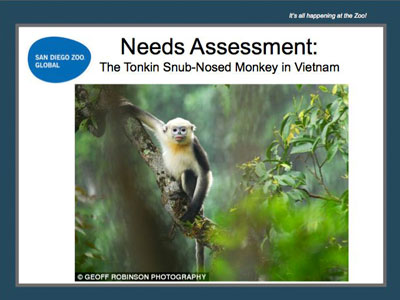 |
Conducting Conservation Projects in the Field: Education, Culture & Ethics |
1.00 |
What makes a successful conservation project? Is it enough to have thorough scientific understanding of the ecological and biological threats facing a species or habitat or do we need to devote significant focus to the human dimension of conservation? Over what time frame should we consider a project successful? What goes into defining a project as being sustainable over the long run so that the perpetuation of the species is guaranteed? How does human economic well-being relate to conservation 1:We improve our conservation strategies by integrating traditional knowledge and practices into the project, and thereby make the project more appropriate for the area and local culture. By cultivating informed, supportive, and involved local communities, the root cause of some of our most pressing conservation problems can be addressed by many more people. With more people involved in the struggle to save endangered species, our projects are more likely to be successful and sustainable. |
 |
Conducting Meetings: Communicating As Meeting Leaders |
0.50 |
Clarity is crucial for conducting an efficient and productive meeting. By communicating clearly, you’ll be able to express ideas, overcome barriers to understanding, and specify expectations. Your ability to communicate clearly will facilitate interactions among participants, and minimize confusion and conflict.
In this course you will learn to: identify the ways to communicate clearly in a meeting, and identify communication styles to avoid, and the ways to enhance relationships with participants. |
 |
Conducting Meetings: Communicating As Meeting Leaders (Instructor Guide) |
0.50 |
Clarity is crucial for conducting an efficient and productive meeting. By communicating clearly, you’ll be able to express ideas, overcome barriers to understanding, and specify expectations. Your ability to communicate clearly will facilitate interactions among participants, and minimize confusion and conflict.
In this course you will learn to: identify the ways to communicate clearly in a meeting, and identify communication styles to avoid, and the ways to enhance relationships with participants.
This Instructor's Edition of this course includes notes and suggestions to assist you in presenting the material, whether in an in-person classroom setting, or as an instructor-led online or distance-learning course. It also provides you with the answers to questions found in mid-lesson activities, as well as in the quiz that concludes the course. |
 |
Conducting Meetings: Communicating Nonverbally |
0.50 |
Individuals are always sending messages, unconsciously or consciously, through nonverbal communication. When verbal and nonverbal communication contradicts one another, nonverbal cues are usually believed. Therefore, it is important that you understand what different types of nonverbal communication can mean, and how these messages can influence the productivity of your meetings.
Learning Objectives: Identify the different ways nonverbal messages can be sent. Interpret nonverbal communication and identify the steps to improve nonverbal communication. |
 |
Conducting Meetings: Communicating Nonverbally (Instructor Guide) |
0.50 |
Individuals are always sending messages, unconsciously or consciously, through nonverbal communication. When verbal and nonverbal communication contradicts one another, nonverbal cues are usually believed. Therefore, it is important that you understand what different types of nonverbal communication can mean, and how these messages can influence the productivity of your meetings.
Learning Objectives: Identify the different ways nonverbal messages can be sent. Interpret nonverbal communication and identify the steps to improve nonverbal communication.
This Instructor's Edition of this course includes notes and suggestions to assist you in presenting the material, whether in an in-person classroom setting, or as an instructor-led online or distance-learning course. It also provides you with the answers to questions found in mid-lesson activities, as well as in the quiz that concludes the course. |
 |
Conducting Meetings: Conflicts, Climates, and Difficult Personalities |
0.50 |
In this course you will learn to: identify the main causes of conflict, the ways to resolve conflict in meetings, and the common difficult personality types in meetings, and identify the characteristics of a positive and negative climate, and the steps to build a positive climate when communicating. |
 |
Conducting Meetings: Conflicts, Climates, and Difficult Personalities (Instructor Guide) |
0.50 |
In this course you will learn to: identify the main causes of conflict, the ways to resolve conflict in meetings, and the common difficult personality types in meetings, and identify the characteristics of a positive and negative climate, and the steps to build a positive climate when communicating.
This Instructor's Edition of this course includes notes and suggestions to assist you in presenting the material, whether in an in-person classroom setting, or as an instructor-led online or distance-learning course. It also provides you with the answers to questions found in mid-lesson activities, as well as in the quiz that concludes the course. |
 |
Conducting Meetings: Fundamentals of Conducting Meetings |
0.67 |
Meetings allow groups to function, define goals, contribute to participants’ morale and status, as well as develop organizational culture. During meetings, participants are able to exchange information and update one another on current events. When information is shared among participants, they are able to work together to create ideas and solutions, and make decisions to progress toward the group’s goals.
In order for a group to function effectively, participants must be working toward accomplishing a common goal. Meetings allow participants to define goals as a group, which helps them agree on the terms of the goals, such as how and when they’ll be accomplished.
When the meeting leader encourages input from participants, employee morale increases. Encouraging communication satisfies the participants’ desire to play an active role in the organization. When participants understand that their opinions are valued, they feel that they’ve contributed to their organization.
Meetings also help develop the organization’s culture when meeting leaders demonstrate the values and attitudes preferred by the organization. Leaders display organizational values in meetings to reinforce the behavior they desire from participants.
In this course you will learn to: identify the benefits, types and misconceptions about meetings, plan a meeting, participate in a meeting, and close a meeting. |
 |
Conducting Meetings: Fundamentals of Conducting Meetings (Instructor Guide) |
0.67 |
Meetings allow groups to function, define goals, contribute to participants’ morale and status, as well as develop organizational culture. During meetings, participants are able to exchange information and update one another on current events. When information is shared among participants, they are able to work together to create ideas and solutions, and make decisions to progress toward the group’s goals.
In order for a group to function effectively, participants must be working toward accomplishing a common goal. Meetings allow participants to define goals as a group, which helps them agree on the terms of the goals, such as how and when they’ll be accomplished.
When the meeting leader encourages input from participants, employee morale increases. Encouraging communication satisfies the participants’ desire to play an active role in the organization. When participants understand that their opinions are valued, they feel that they’ve contributed to their organization.
Meetings also help develop the organization’s culture when meeting leaders demonstrate the values and attitudes preferred by the organization. Leaders display organizational values in meetings to reinforce the behavior they desire from participants.
In this course you will learn to: identify the benefits, types and misconceptions about meetings, plan a meeting, participate in a meeting, and close a meeting.
This Instructor's Edition of this course includes notes and suggestions to assist you in presenting the material, whether in an in-person classroom setting, or as an instructor-led online or distance-learning course. It also provides you with the answers to questions found in mid-lesson activities, as well as in the quiz that concludes the course. |
 |
Conducting Meetings: Listening Effectively and Asking Questions |
0.50 |
To communicate effectively during a meeting, you have to listen and ask appropriate questions. Listening and questioning are two interdependent skills that will help you create a positive climate, develop positive dialog, and achieve the group’s goals.
By listening and questioning effectively, you’ll actively engage yourself and others in the meeting. Actively participating will enable you to quickly identify and address other participants’ thoughts, ideas, and concerns. Facilitating communication in this manner will foster individual and group success.
In this course you will learn to: identify the main causes of conflict, the ways to resolve conflict in meetings, and the common difficult personality types in meetings, and identify the characteristics of a positive and negative climate, and the steps to build a positive climate when communicating. |
 |
Conducting Meetings: Listening Effectively and Asking Questions (Instructor Guide) |
0.50 |
To communicate effectively during a meeting, you have to listen and ask appropriate questions. Listening and questioning are two interdependent skills that will help you create a positive climate, develop positive dialog, and achieve the group’s goals.
By listening and questioning effectively, you’ll actively engage yourself and others in the meeting. Actively participating will enable you to quickly identify and address other participants’ thoughts, ideas, and concerns. Facilitating communication in this manner will foster individual and group success.
In this course you will learn to: identify the main causes of conflict, the ways to resolve conflict in meetings, and the common difficult personality types in meetings, and identify the characteristics of a positive and negative climate, and the steps to build a positive climate when communicating.
This Instructor's Edition of this course includes notes and suggestions to assist you in presenting the material, whether in an in-person classroom setting, or as an instructor-led online or distance-learning course. It also provides you with the answers to questions found in mid-lesson activities, as well as in the quiz that concludes the course. |
 |
Conducting Meetings: Managing Meetings |
0.67 |
In this course you will learn to: identify the types of meeting leaders and the characteristics of an effective meeting leader. identify the process to follow when making decisions in a meeting, and explain how to identify and minimize group think in meetings. |
 |
Conducting Meetings: Managing Meetings (Instructor Guide) |
0.67 |
In this course you will learn to: identify the types of meeting leaders and the characteristics of an effective meeting leader. identify the process to follow when making decisions in a meeting, and explain how to identify and minimize group think in meetings.
This Instructor's Edition of this course includes notes and suggestions to assist you in presenting the material, whether in an in-person classroom setting or as an instructor-led online or distance-learning course. It also provides you with the answers to questions found in mid-lesson activities, as well as in the quiz that concludes the course. |
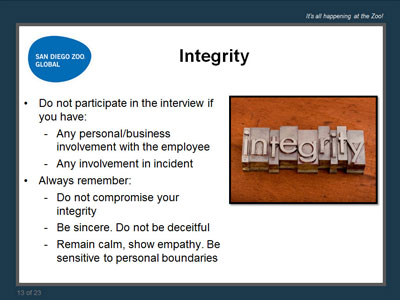 |
Conducting World Class Employee Investigations |
1.00 |
Employment litigation and claims in recent years have cost employers billions of dollars. Employers must find ways to reduce their vulnerability to such claims. Often times, employer liability hinges on the quality of the company's investigation into complaints of discrimination, harassment, or other claims of workplace misconduct. In fact, an important consideration in an employee's decision to ultimately file a lawsuit or claim is whether the employer conducted an effective workplace investigation. Join San Diego Zoo Global's Associate Director of Human Resources for a dynamic and informative workshop on how to conduct effective workplace investigations that will protect your organization and reduce potential litigation costs. This comprehensive webinar will include a discussion about:
- A step-by-step approach on how to plan and conduct workplace investigations
- A practical demonstration of effective interview techniques
- How to anticipate and respond to legal and practical issues that frequently arise during the course of investigations
- Preparing bullet-proof documentation to support the investigation findings and recommended actions |
 |
Conflict and Communication: Why Can't We Be Friends? |
1.00 |
Conflict occurs when we are in relationship with others. In fact, the hallmark of a healthy relationship is not the absence of conflict, but the ability to successfully resolve it. Unfortunately, resolving conflict is not a skill many of us were taught. We'll explore the fundamental causes of conflict and the dynamics that can escalate conflict. Finally, we’ll cover the tools necessary to navigate conflict successfully, including effective communication strategies. |
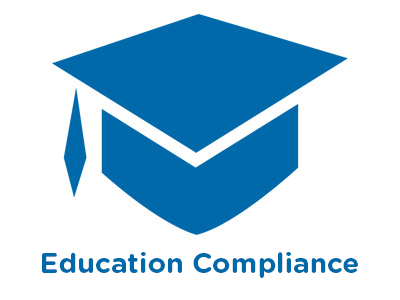 |
Conflicts of Interest |
1.00 |
A conflict of interest is a clash between personal interests and work requirements. It occurs when an individual’s personal interests, whether financial, professional, or social, including those of family and friends, compromise his or her judgment, decision, or actions in the workplace. Conflicts of interest matter because they compromise the quality of an employee’s decision-making, which reflects on higher education institutions. |
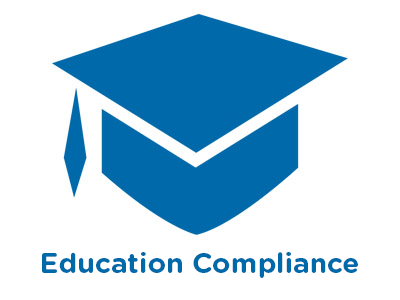 |
Conflicts of Interest (Corrections) |
1.00 |
A conflict of interest is a clash between personal interests and work requirements. It occurs when an individual’s personal interests, whether financial, professional, or social, including those of family and friends, compromise his or her judgment, decision, or actions in the workplace. Conflicts of interest matter because they compromise the quality of an employee’s decision-making, which reflects on higher education institutions. |
 |
Connecticut Sexual Harassment Prevention Training |
2.00 |
This 2 hour Connecticut Sexual Harassment Prevention Training is brought to you by the Connecticut Commission on Human Rights and Opportunities.
Thank you to the Connecticut Commission on Human Rights and Opportunities' for allowing us to use their materials from the Sexual Harassment Prevention Training course. |
 |
Connecting Volunteers in the 21st Century |
1.00 |
Feeling bogged down by repetitive communication? Strapped for time and resources? Ensuring volunteers have all the training materials they need at their fingertips can be an exceptionally daunting task, especially for those with a healthy fear of technology. Yet the time savings involved can be astronomical, both in training time and resources. Learn how the San Diego Zoo tackled the challenge, launching a new Volunteer Connection web site on which to post a wide variety of training materials that volunteers can access from the comfort of their own homes. Investigate how this unique site has become a safe social network for San Diego Zoo Global Volunteers. We will dive right into the challenges, techniques, questions and concerns this site has posed for us and how we've addressed each. Experience the site's functionality, and learn how you can start up a portal site like this for your volunteers too!! |
 |
Connection Planning in Long-Term Care |
1.00 |
This module includes training for staff and providers in the importance of social connection and practical strategies learners can use to promote social connectedness in long-term care. The module explains how to implement Connection Planning, a brief, person-centered behavioral intervention for developing resident care plans that address social connection. Connection Planning includes evidence-informed, practical strategies to promote meaningful social connection among residents in long-term care. |
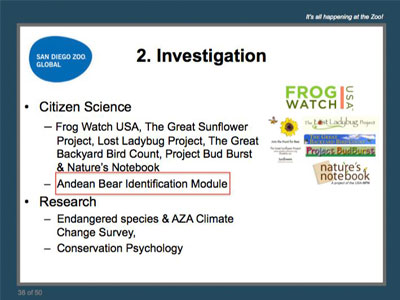 |
Conservation Education: A Brief History, Current Challenges and Future Directions |
1.00 |
The field of conservation education has experienced significant paradigm shifts since its said-to-be inception in the 1960's. While many advances have been made in the field of conservation education, many challenges and varying viewpoints remain. This is especially true as many conservation related issues are underpinned by political, economic and cultural opinions and allegiances. Using the literature and projects underway at the San Diego Zoo Institute for Conservation Research and beyond, we will discuss these changes and challenges, while exploring what the future of conservation education may have in store. |
 |
Constructing: Airway Essentials—Part 1 |
0.50 |
We think that you will appreciate the opportunity to review the essential aspects of Airway Assessment and Management with one of the most dedicated paramedics that you can find: Chris Galton. As a Transplant Anesthesiologist and a Paramedic, Galton has spent countless hours learning to assess and maintain some of the most difficult patient airways out there. Instead of going to bed after staying up all night on a liver transplant case, Galton showed some paramedic-style grit and shared some knowledge with Rachel and Rich (two experienced paramedics). The cameras were rolling and you will want to see what they spoke about. |
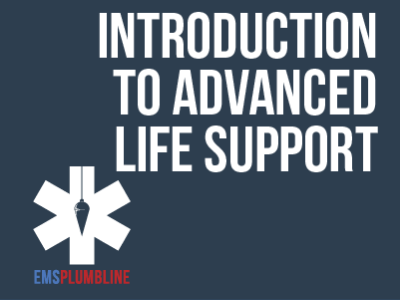 |
Constructing: Airway Essentials—Part 2 |
0.50 |
Most paramedics will remember walking around town during their original paramedic school and deciding which patients would be a "tough tube." If that describes you when you first started, you will appreciate this brief review. Dr. Christopher Galton takes the time to takes the time to give a memorable examples of the mnemonics LEMON and BONES, which prove to be a fantastic teaching tools. We think you will enjoy the illustrations that allow you to remember these important evaluations. Final Exam: This multiple choice exam is designed to test your knowledge of the material you just reviewed. You have two attempts to gain an 80% or higher on this exam. Please take your time and answer each question carefully.
|
 |
Constructing: Airway Essentials—Part 3 |
1.00 |
Knowing why you are doing what you are doing will almost always produce a better result. In this case, Dr. Christopher Galton explains why we ventilate at the rates and the volumes we do. This insightful discussion will offer ideas on how to use the ventilation tools that we encounter every day. Final Exam: This multiple choice exam is designed to test your knowledge of the material you just reviewed. You have two attempts to gain an 80% or higher on this exam. Please take your time and answer each question carefully. |
 |
Constructing: Airway Essentials—Part 4 |
1.00 |
This lesson explores a few BLS concepts that every ALS provider should know. You will appreciate the back-to-basics approach Dr. Christopher Galton, uses to ensure adequate ventilation. Final Exam:This multiple choice exam is designed to test your knowledge of the material you just reviewed. You have two attempts to gain an 80% or higher on this exam. Please take your time and answer each question carefully. |


























